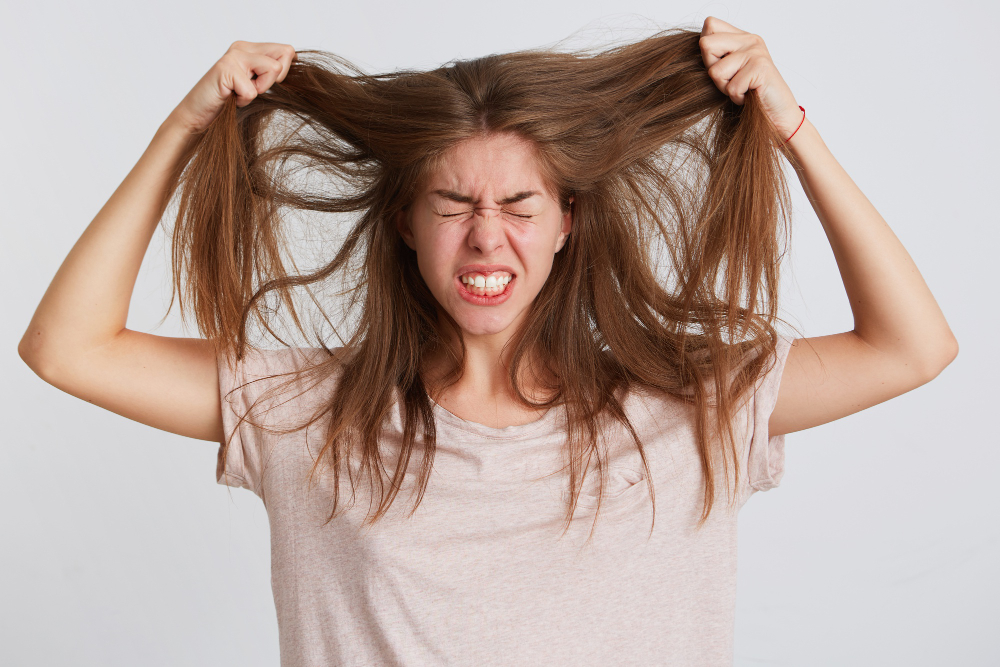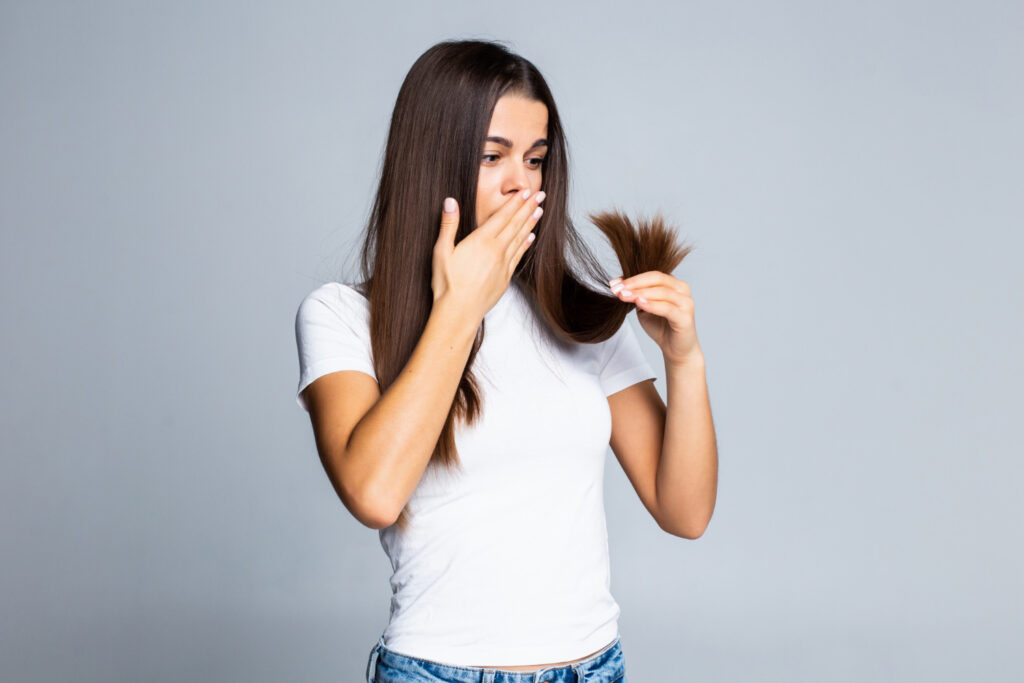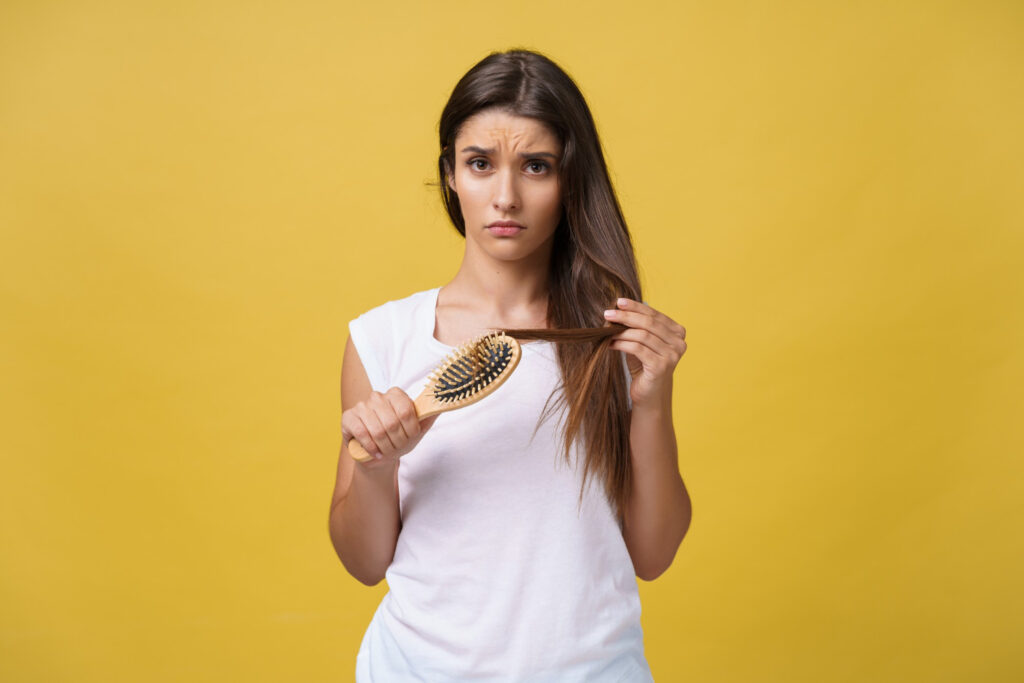After including the most recommended steps that help repair heat-damaged hair in the previous article, today We’re going to discuss how to repair chemically damaged hair efficiently and quickly.
Sometimes, we can’t resist the temptation of dyeing, bleaching, or chemically treating our hair to get that sexy new look! But after doing this, you may notice your hair becomes dry, dull, brittle, weak, and overly damaged. So, what you should do to fix this? Below, I will share the top 11 steps on how to repair chemically damaged hair, the causes and signs of chemically damaged hair, and more FAQs.
Let’s get started…
Table of Contents
Key Takeaways:
- Hair dyeing, bleaching, and frequent use of hairstyling tools are the main causes of chemically damaged hair.
- Chemically damaged hair signs include split ends, hair loss, shedding, breakage, lack of moisture and shine, frizz, dryness, and weakness.
- Washing your hair with chemical-free shampoo, applying hair masks, massaging the scalp, conditioning the hair after every wash, using a microfiber towel, eating healthy food, and protecting the hair from UV rays can help repair chemically damaged hair successfully.
What Are The Causes Of Chemically Damaged Hair?
Three common factors are usually responsible for causing chemical damage to your hair:
- Chemical hair dye strips your hair of its natural moisture, leaving it dry, weak, and dull. Hairstylists use harsh chemicals to dye your hair which will weaken the hair cuticle or the protective outer layer of the hair. To reduce the damage, it’s best to dye your hair 2-3 shades darker than your natural color.
- Using hairstyling tools regularly can severely damage your hair. They make your hair break easily and lose its natural moisture and elasticity fast. Plus, if your hair is colored and you use heat styling tools, your hair will suffer even more.
- Bleaching damage hair drastically as it changes hair color from dark to light which will suck out all the natural moisture in your hair and leave it dry, dull, and rough. Plus, regular bleaching will damage your hair severely and could lead to hair loss.
What Does Chemically Damaged Hair Look Like?

When your hair is chemically damaged:
- It will lose its natural shine.
- You will notice visible split ends. The hair shaft will split into pieces ( 2-3 fragments at the ends or in the middle).
- Hair loses its natural moisture and elasticity. It feels rough, dry, and brittle all the time.
- It looks super thin when it’s wet.
- It may start to fall out.
- Hair becomes frizzy and loses its strength.
- It breaks easily.
- If you have curly or wavy hair, curls look undefined and may become straight.
How To Repair Chemically Damaged Hair?
To repair chemically damaged hair, follow the next tips and at-home remedies:
1- Go Easy On Treatments
The first thing to do is to give your hair a break. How to do this? Don’t use hairstyling tools for a while and avoid dyeing or bleaching your hair. You should also avoid any hair treatment that is known to weaken hair health.
This will help your hair regain its strength, restore its shine and moisture, and improve scalp health.
2- Apply Hair Masks Weekly
Hair masks or oil soak treatments are one of the highly recommended steps on how to repair chemically damaged hair as they can effectively treat your hair and improve its health.
It’s best to use hair masks 1-2 times a week and to make your hair masks at home so, you can add the ingredients you want to the recipe and exclude what could irritate your scalp or affect your hair health.
Natural hair mask recipes are easy to make. And they can promote healthy hair growth, soften strands, combat frizz, keep your curls defined, and add shine to your hair.
They should contain ingredients like rice water, olive oil, coconut oil, aloe vera, rose water, honey, yogurt, moringa oil, avocado oil, ashwagandha oil, or argan oil.
Looking for natural hair mask recipes? If you have curly or wavy hair, check out this article. And if your hair is straight, check out those recipes.
Pro Tip:
After applying hair masks to your scalp and hair, massage your scalp as it’s proven this can promote blood circulation in the scalp, boost hair growth, and increase hair thickness.
3- Use Natural Shampoo
Shampoos that are formulated with harsh chemicals like sulfate, paraben, synthetic fragrances, or formaldehyde will worsen your hair condition.
Your hair is already fragile and damaged due to the chemical treatments so it’s best to look for a natural shampoo that contains mild surfactants.
It should be also enriched with repairing and moisturizing ingredients like aloe vera, argan oil, avocado oil, vitamin E, or biotin.
A natural shampoo will cleanse your scalp and hair well in addition to nourishing your hair and treating scalp issues without stripping them of their natural moisture.
4- Condition Your Hair
After shampooing your hair, it’s essential to condition your hair. Don’t skip this step as using a conditioner help smoothen hair strands, prevent frizz, strengthen hair, and keep it manageable and tangle-free.
Like hair masks, making your conditioner at home is a good idea as the last thing you need is to apply a conditioner that is full of chemicals to your already chemically damaged hair.
The great thing about homemade conditioners is you will have control over the ingredients and you can use only the ingredients that you know are beneficial for your hair.
Looking For the best homemade hair conditioner recipes? Check out this article.

5- Limit The Use Of Hairstyling Tools
Regular use of hairstyling tools without protection can affect your hair health drastically. They can dry out hair, strip it of its natural moisture, and make it break easily. Your hair will be also frizzy constantly and have visible split ends.
So what should you do instead? avoid using hairstyling tools daily, apply heat protectant spray to your damp hair before using the tools, and try heat-free methods to curl or straighten your hair.
6- Protect Your Hair From UV Rays
Avoid going out in the morning without applying hair and scalp sunscreen to protect your hair from UV harmful rays.
Frequent exposure to the sunlight without protection can dry out your hair and make it appear fried and frizzy and lose its natural shine.
7- Eat More Nutritious Meals
There’s no doubt that eating habits have a direct impact on your overall health including your hair health. If you eat daily junk food or unhealthy fatty food, don’t expect to grow healthy and strong hair.
But if you consume healthy nutritious meals every day, your hair health will definitely improve.
Healthy foods include lean protein, vegetables, leafy greens, fruits, whole grains, nuts, and legumes.
They are super nutritious and full of antioxidants, minerals, and vitamins. Plus, they have anti-inflammatory properties. All this can stimulate hair growth, boost hair texture, reduce inflammation and scalp issues, and moisturize and strengthen your hair follicles.
8- Wear A Swim Cap
If you usually swim, it’s strongly recommended to wear a swim cap. And if it’s possible, wash your hair after swimming.
Swimming pools contain chlorine, bromine, and other harsh chemicals that can damage hair and make chemically damaged hair look even worse.
Those chemicals can cause color fading, dry out your hair, and make your hair frizzy and more prone to breakage.
Pro Tip:
Wet your hair and add conditioner to it before going to swim. This step will reduce damage as your hair won’t be able to absorb more water because it’s already full of water.
9- Cut Split Ends Regularly
One of the common signs of chemically damaged hair is split ends, they make your hair appear unhealthy and frizzy. How to fix this? Split ends are not reversed, what you’ll have to do is cut them off so your ends look fresh and healthy.
Plus, it’s recommended to cut your ends every 2-3 months to maintain your hair health and get rid of damaged ends regularly.
10- Comb Your Hair Gently

After washing your hair, use a wide-tooth comb to detangle your hair gently without breaking or causing more damage to your hair.
Start from the ends of your hair then work upward to detangle knots without pulling strands harshly to avoid hair loss.
Also, don’t tie your hair up tight as this can put a strain on the scalp and hair which will lead to breakage and brittleness.
11- Use A Microfiber Towel
Use a microfiber towel or old cotton t-shirt to dry your hair as they can absorb excess water without causing friction or damaging hair texture.
Also, avoid rubbing your hair harshly as this can make your strands feel rough, dry, and weak.
FAQs:
How Long Does Chemically Damaged Hair Take To Repair?
On average, it takes 6-12 months to notice the difference. Your hair texture will improve, breakage and frizz will be reduced, and new healthy hair will replace those damaged strands.
Can You Reverse Chemical Damage To Hair?
No. Chemically damaged hair can not be reversed but you can follow some steps to reduce the damage and help grow new healthy hair. Those steps include using natural hair masks, washing your hair with chemical-free shampoo, conditioning your hair, using heat protectant spray and hair and scalp sunscreen, and drying your hair with a microfiber towel.
Does Cutting Off Damaged Hair Help It Grow?
Cutting damaged ends regularly will give your hair a more fresh and fuller appearance. And it can help reduce breakage and promote healthy hair growth.
Wrapping Up
The steps on how to repair chemically damaged hair will absolutely help restore hair shine, improve its appearance, promote healthy hair growth, and keep it strong. So, follow those steps and let me in the comments down below if I missed a step!
Feature Image Source: Pexels.com/@cottonbro
